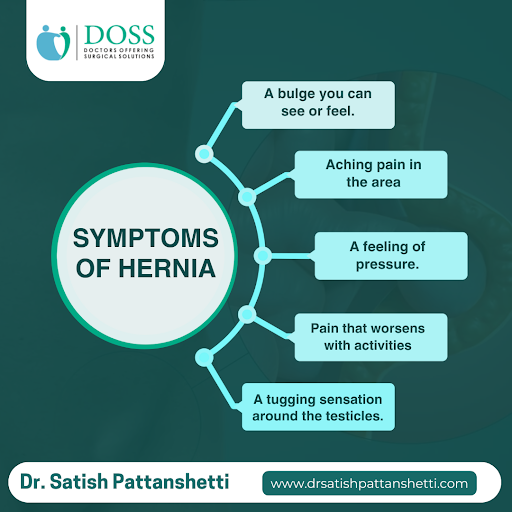Symptoms of Hernia
A hernia occurs when an organ or fatty tissue pushes through a weak spot in the surrounding muscle or connective tissue. While some hernias are asymptomatic and may go unnoticed, others can cause discomfort and lead to serious complications if left untreated. Knowing the symptoms of a hernia can help you identify the condition early and seek appropriate medical attention.
1. A Visible Lump or Bulge
One of the hallmark signs of a hernia is the appearance of a lump or bulge in the affected area, such as the abdomen, groin, or chest.
- Key Characteristics:
- The bulge may become more pronounced when standing, coughing, or straining.
- It might disappear or reduce in size when lying down.
- In some cases, you may be able to push the bulge back in, a condition known as a “reducible hernia.”
2. Pain or Discomfort
Pain or discomfort is another common symptom, often aggravated by physical activities that increase abdominal pressure.
- Common Triggers: Heavy lifting, coughing, bending, or prolonged standing.
- The pain may range from a dull ache to a sharp or burning sensation.
3. A Heavy or Pulling Sensation
Many individuals describe a sense of heaviness or pressure in the area of the hernia. It may feel like something is “dragging” inside, particularly after standing for long periods or engaging in strenuous activity.
4. Swelling and Tenderness
In some cases, hernias can cause localized swelling or tenderness. The affected area may feel inflamed or sensitive to touch, especially after periods of exertion.
5. Changes in Digestion or Bowel Movements
Certain types of hernias, particularly those in the abdomen, can lead to gastrointestinal symptoms:
- Constipation or difficulty passing stool.
- Bloating or a feeling of fullness, even after eating small amounts.
- In severe cases, a hernia can obstruct the bowel, causing a medical emergency.
6. Burning or Aching Around the Area
Some hernias cause a burning, aching, or sharp pain that radiates from the hernia site. This sensation can worsen over time or with increased physical activity.
7. Nausea and Vomiting (Emergency Symptom)
When a hernia becomes trapped (incarcerated) or strangulated (cuts off blood supply to the tissue), it can lead to severe symptoms, including:
- Intense abdominal pain.
- Nausea and vomiting.
- Redness, warmth, or discoloration around the hernia. This is a medical emergency requiring immediate attention.
Common Locations and Their Symptoms
Hernias can occur in different parts of the body, and symptoms may vary depending on the type:
- Inguinal Hernia (Groin): Bulge or pain in the groin, especially during movement or exertion.
- Umbilical Hernia (Belly Button): Swelling or discomfort around the navel.
- Hiatal Hernia (Diaphragm): Acid reflux, heartburn, or difficulty swallowing.
- Incisional Hernia: Bulge at the site of a previous surgical incision.
When to See a Doctor
It’s important to seek medical advice if you experience:
- A persistent or growing lump.
- Pain that worsens over time or interferes with daily activities.
- Nausea, vomiting, or signs of bowel obstruction.
- Redness or warmth around the hernia site.
Takeaway
Hernias may start as a minor inconvenience, but they can lead to significant complications if untreated. Recognizing the symptoms early and consulting with a healthcare provider can ensure timely diagnosis and treatment. Whether it’s managing discomfort or undergoing surgical repair, addressing a hernia promptly can help prevent long-term health issues.

